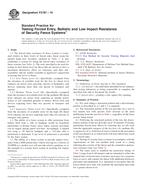Potrebujeme váš súhlas na využitie jednotlivých dát, aby sa vám okrem iného mohli ukazovať informácie týkajúce sa vašich záujmov. Súhlas udelíte kliknutím na tlačidlo „OK“.
ASTM F2781-10
Standard Practice for Testing Forced Entry, Ballistic and Low Impact Resistance of Security Fence Systems
Automaticky preložený názov:
Štandardný postup skúšania násilného vniknutia, Ballistic a odolnosť voči nárazu bezpečnostných plotové systémy
NORMA vydaná dňa 1.7.2010
Informácie o norme:
Označenie normy: ASTM F2781-10
Poznámka: NEPLATNÁ
Dátum vydania normy: 1.7.2010
Kód tovaru: NS-54526
Počet strán: 10
Približná hmotnosť: 30 g (0.07 libier)
Krajina: Americká technická norma
Kategória: Technické normy ASTM
Anotácia textu normy ASTM F2781-10 :
Keywords:
ICS Number Code 13.310 (Protection against crime)
Doplňujúce informácie
| Significance and Use | ||||||||
|
The success or failure of any attempt to forcefully penetrate a fence system is dependent upon three primary factors that collectively define the threatthe tools and devices employed, the number of aggressors, and their level of sophistication. Normally, a test procedure of this scope would be supported by years of laboratory testing intended to qualify and accurately reproduce the destructive effects of a variety of tools, implements, and devices. However, rapidly changing social conditions have created an immediate need for building components resistant to evolving forced entry techniques. Accordingly, the procedures presented herein are based more on field experience than laboratory analysis. They are more representative than inclusive, are intended to provide a basis for the comparative evaluation of different fence systems using forced penetration procedures, ballistic tests and impact testing, and are not primarily intended to be used to establish or confirm the absolute prevention of forced entries. |
||||||||
| 1. Scope | ||||||||
|
1.1 The forced entry resistance of fence systems is evaluated relative to three levels of forced entry threat using the limited hand tool inventory outlined in Table 1. It also establishes a system for rating the forced entry resistance of those systems (see Table 2). The tools specified to be used for testing at each threat level are those that are known to have a maximum destructive effect on structures and their sub-assemblies and are readily available to aggressors categorized as posing that level of threat. 1.1.1 Low Threat Level (L)—Specifically exempted from the inventory of available tools for the low (L) threat level category are power tools (gasoline, electric or hydraulic), and devices requiring more than one person to transport and operate. 1.1.2 Medium Threat Level (M)—Specifically exempted from the inventory of available tools for the medium (M) threat level category are power tools requiring an outside power source or self contained gasoline or battery driven tools and devices requiring more than two persons to transport and operate. 1.1.3 Aggressive Threat Level (A)—Specifically exempted from the inventory of available tools for the high (H) threat level category are devices requiring more than two persons to transport and operate. 1.2 The ability of a fence system to offer protection from bullets fired from a rifle or handgun would be beneficial particularly in Border Fence areas where security personnel can be targets during patrol activities. Accordingly, a limited test using a .38 Special handgun and a 7.62-mm rifle is performed to determine if any level of protection is provided by the fence system. 1.3 The ability of a fence system to provide impact resistance from a 4000 pound mass vehicle moving at a velocity of 20 MPH at a modest cost will provide relative guidance as to the strength of a security fence system in resisting low impact situations. |
||||||||
| 2. Referenced Documents | ||||||||
|
Odporúčame:
Aktualizácia technických noriem
Chcete mať istotu, že používate len platné technické normy?
Ponúkame Vám riešenie, ktoré Vám zaistí mesačný prehľad o aktuálnosti noriem, ktoré používate.
Chcete vedieť viac informácií ? Pozrite sa na túto stránku.




 Cookies
Cookies
